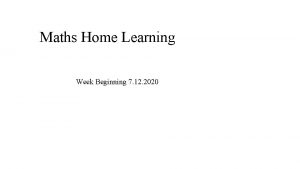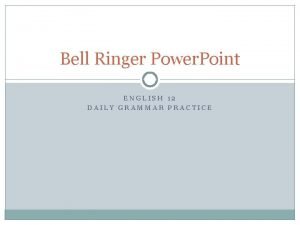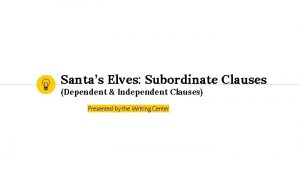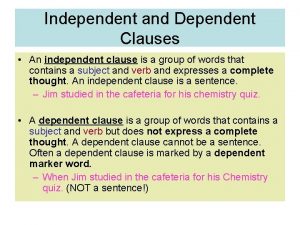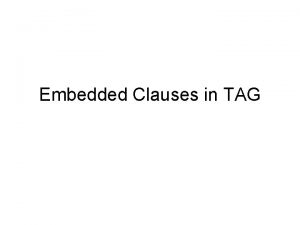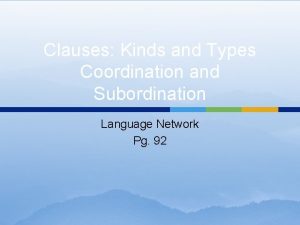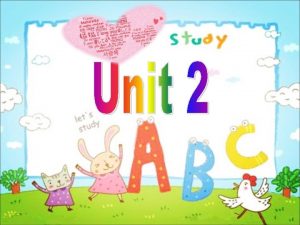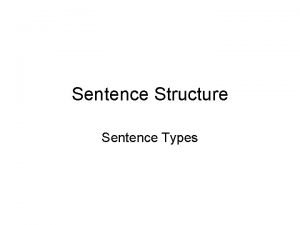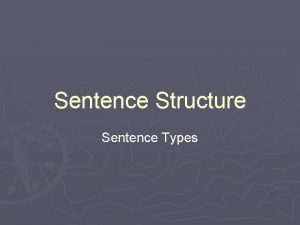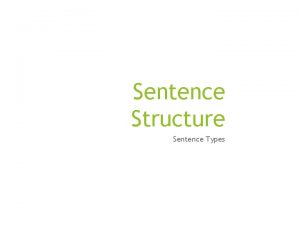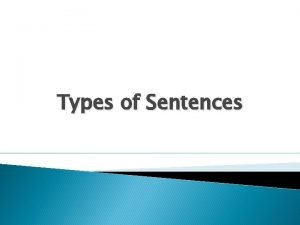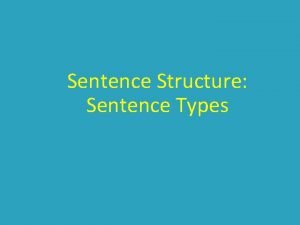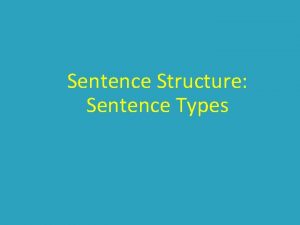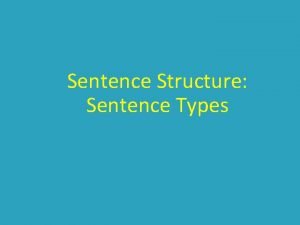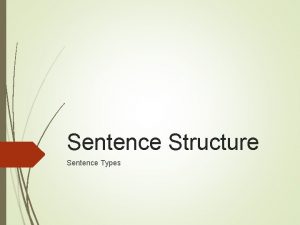Grammar Lessons Week 6 Clause and Sentence Types













- Slides: 13

Grammar Lessons – Week 6 Clause and Sentence Types

Day 1 – Types of Clauses • To be a clause, a group of words must have a subject and a verb. • Independent clauses have a subject, a verb, and can stand alone. • Dependent clauses have a subject, a verb, and cannot stand alone.

Day 1 – Examples • Independent Clauses vs. Dependent Clauses – I like cheese – While I like cheese vs – Gilbert ran down the street vs – Although Gilbert ran down the street – The show was on vs – Unless the show was on – No cheese was on the sandwich vs – Because no cheese was on the sandwich

Day 1 – Practice Identifying • Which types of clauses are these? – Joe-Bob built a fence. – While Gilbert complained – Unless Floober misunderstood him • There are two types of clauses in each sentence, here. Which one is which? – While Bobbi-Jo likes plaid, Floober prefers plain colors. – I like weekends because I can sleep in.

Day 2 – Recapping • Yesterday, we talked about clauses – independent and dependent. • Independent clauses can stand alone. • Dependent clauses can’t. • Now let’s talk about what we do with them.

Day 2 – Clauses to Sentences • Each sentence needs, bare minimum, one independent clause. • There are four types of sentences, dependent on what clauses are in them: – – Simple – One independent clause. Compound – Two independent clauses (or more). Complex – One independent (only) and one (or more) dependent clauses. Compound-Complex – Two independent clauses (or more) and one dependent clause (or more). • If you want the simple version: – – Simple – One ind. Compound – Two ind. Complex – One ind, one dep. Compound-Complex – Two ind, one dep.

Day 2 – Identifying Sentence Types • Let’s identify the clauses, then the sentence type, in each of these: – Floober is a stupid name. – When he heard me call his name stupid, Floober was offended. – Floober is an imaginary person, so I don’t care. – Joe-Bob cares, and he consoles Floober. – Joe-Bob and Floober are now friends because I insulted Floober’s name.

Day 3 – Recap • This week, we’ve discussed the following: – Independent Clauses – Subject, verb, stand alone – Dependent Clauses – Subject, verb, can’t stand alone – Simple Sentence – One ind cl – Compound Sentence – Two ind cl – Complex Sentence – One ind cl, one dep cl – Compound-Complex Sentence – Two ind cl, one dep cl • Today, let’s discuss how to properly join two clauses.

Day 3 – Joining Two Clauses • Joining a dependent clause to an independent clause can happen various ways; here’s two options: – Start with the dependent clause: – Because I wanted beef, I ordered the twelve ounce steak. – Notice the comma between the dep cl and ind cl. – End with the dependent clause: – I ordered the twelve ounce steak because I wanted beef. – Notice there’s no comma now, since we ended with the dep cl.

Day 3 – Joining Two Clauses • Joining two independent clauses has many more options to choose from: – – – A comma plus a coordinating conjunction: (CCs include For, And, Nor, But, Or, Yet, So) I ordered the steak, and she also ordered the steak. I ordered the steak, but she ordered the salad. I could order the steak, or I could order the potato skins as an entrée. – OR you could join two ind cl with a semi-colon by itself; – I like cheese; I eat it often. – OR with a semi-colon, conjunctive adverb or transitional phrase, and comma – I like cheese; consequently, I eat it often. – OR even with a colon, if the latter defines or expands upon the former – I like cheese: today, I devoured some very delicious provolone.

Day 4 – Recapping • • • Clauses vs Phrases Subjects – Implied and not Verbs Verbals Direct and Indirect Objects • Now, we’re going to bring back something we went over a while ago and add it to the mix: predicate adjectives and predicate nominatives.

Day 4 – DO, IO, PA, PN • Action verbs take direct objects and, sometimes, indirect objects. • A subject performs an action, and the object receives the action. – I want cheese. – Wumpus bites toy burgers. • Linking verbs, however, take predicate adjectives or predicate nominatives. • Here, the subject equals the predicate. We’re equating the subject with a state of being.

Day 4 - Practice • Let’s try finding them, together: – When Gilbert sat in his comfy chair, he wanted both a book and a cup of coffee. – Whether you use Italian dressing or balsamic vinaigrette, the salad will still be tasty. – Neither the pig nor the sheep knew what to say. – When you get to the castle, you’ll either have to open the draw-bridge or scale the walls.
 /lessons/cntfk2dqjid2lq/week-7a
/lessons/cntfk2dqjid2lq/week-7a Week by week plans for documenting children's development
Week by week plans for documenting children's development Supporting sentence examples
Supporting sentence examples Left linear grammar
Left linear grammar Bell ringer grammar
Bell ringer grammar Main clause and subordinate clause
Main clause and subordinate clause Phrases vs sentences
Phrases vs sentences Dependent clauses
Dependent clauses Independent clause with conjunction
Independent clause with conjunction Come first conditional
Come first conditional What is a matrix clause
What is a matrix clause Coordinate and subordinate clauses
Coordinate and subordinate clauses Adverb warm
Adverb warm If-clause and main clause
If-clause and main clause
